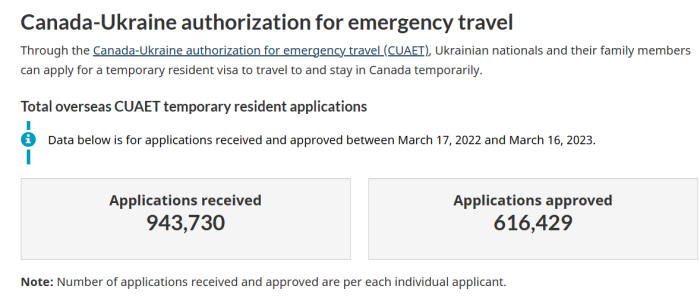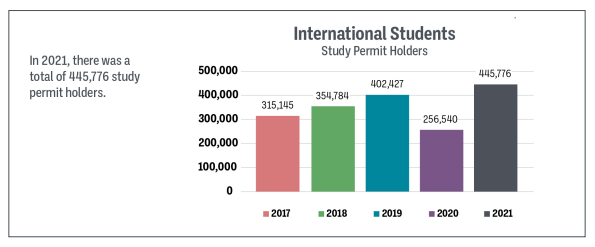

Statistics Canada has finally shown what’s been obvious for a long time: the actual numbers of people coming in are a lot higher than what’s publicly talked about. Specifically, over 1 million people came to Canada on some kind of visa.
The usual disclaimer needs to be added: this is just the official numbers, and they are estimates. It’s difficult to get information on how many people have left, or died.
StatsCan explains it as “Net international migration refers to the total number of moves between Canada and abroad that result in a change in the usual place of residence. It is calculated by adding immigrants, returning emigrants and net non-permanent residents, then subtracting emigrants and net temporary emigration.”
One source that’s expected to grow is from Ukraine.
Of the 943,730 applications for CUETAs, Canada-Ukraine authorization for emergency travel, 616,429 have already been approved. That’s about two thirds. Some 133,323 have already arrived, according to Government statistics.
Temporary immigration is the leading contributor to Canada’s growth
Nice to finally see this admitted.
It’s been frustrating to see how limited the Overton window is. Typically, the only number that gets talked about is the 300,000 or 400,000 that obtain permanent residency. There’s a much bigger picture to look at than just this.
Canada is exploding in size, but not because there is some baby-boom happening locally. Instead, the options available to come keep growing.
In 2022, the reason behind Canada’s record-high population growth was somewhat different, since international migration accounted for nearly all growth recorded (95.9%).
What else does Ottawa have to say about this?
For the year 2022, Canada welcomed 437,180 immigrants and saw a net increase of the number of non-permanent residents estimated at 607,782. Both of these numbers represent the highest levels on record, reflecting higher immigration targets and a record-breaking year for the processing of immigration applications at Immigration, Refugees and Citizenship Canada.
The estimated gains in non-permanent residents recorded for 2022 are the highest for a single calendar year for which comparable data are available. Furthermore, it is the first time these gains are superior to those from immigrants over the same period.
All provinces and territories saw a year-over-year increase in the net estimated number of non-permanent residents in 2022, with work and study permits, in addition to the number of asylum claimants, up across the country. This increase is because of a combination of factors, including the aforementioned intent to leverage international migration to help fulfill employment needs across the country and the program created to welcome people fleeing the Russian invasion of Ukraine.
This is something that has been talked about here for several years: by omitting various temporary categories from public discussion, it paints a very distorted picture about how many people are actually entering each year.
It’s an issue that many so-called “truthers” and “dissidents” have been unwilling to address. Sure, they’ll go on about Roxham Road, but not this.
The most recent Annual Report to Parliament is 2022 (which covers the year 2021). It’s a bit frustrating as these reports used “new visas” and “total visas” almost interchangeably at times. I believe these are actually new visas issued.


And over the last few decades:
| Year | Stu | TFWP | IMP | Total | |
|---|---|---|---|---|---|
| 2003 | 61,293 | 82,151 | – | 143,444 | |
| 2004 | 56,536 | 90,668 | – | 147,204 | |
| 2005 | 57,476 | 99,146 | – | 156,622 | |
| 2006 | 61,703 | 112,658 | – | 174,361 | |
| 2007 | 64,636 | 165,198 | – | 229,834 | |
| 2008 | 79,509 | 192,519 | – | 272,028 | |
| 2009 | 85,140 | 178,478 | – | 263,618 | |
| 2010 | 96,157 | 182,276 | – | 278,433 | |
| 2011 | 98,383 | 190,842 | – | 289,225 | |
| 2012 | 104,810 | 213,573 | – | 318,383 | |
| 2013 | 111,865 | 221,310 | – | 333,175 | |
| 2014 | 127,698 | 95,086 | 197,924 | 420,078 | |
| 2015 | 219,143 | 73,016 | 175,967 | 468,126 | |
| 2016 | 265,111 | 78,402 | 207,829 | 551,342 | |
| 2017 | 317,328 | 78,788 | 224,033 | 620,149 | |
| 2018 | 356,876 | 84,229 | 255,034 | 696,139 | |
| 2019 | 402,427 | 98,310 | 306,797 | 807,534 | |
| 2020 | 256,740 | 84,609 | 242,130 | 583,452 | |
| 2021 | 445,776 | 103,552 | 313,294 | 862,622 |
Stu = Student Visa
TFWP = Temporary Foreign Worker Program
IMP = International Mobility Program
A few problems with this data: either the Feds don’t know how many people leave afterwards, or they just don’t make it easy to find.
For international students graduating, there is the PGWP, the Post Graduate Work Permit. While that was once limited to a single year, it eventually became 3. Now, there is an 18 month extension available, pushing it to 4 1/2 years.
Then we get things like this:

Right now, in cities across the country, it is too hard to build the housing we need, particularly affordable housing. Housing policies are often barriers to producing results and many Canadians – from young families, to seniors, to newcomers – are finding it harder to find an affordable place to call home. It is clear that we need to accelerate change so the system works for all Canadians.
The Prime Minister, Justin Trudeau, was in Guelph, Ontario today to launch the Housing Accelerator Fund (HAF), a $4 billion initiative that will provide funding for local governments to fast track the creation of 100,000 new homes across Canada. Local governments are now invited to develop innovative action plans, in line with the flexible criteria, to remove barriers to building more homes, faster.
The Fund will help cities, towns, and Indigenous governments unlock new housing supply by speeding up development and approvals, like fixing out-of-date permitting systems, introducing zoning reforms to build more density, or incentivizing development close to public transit. Local governments are encouraged to think big and be innovative in their approaches. They could be accelerating project timelines, allowing increased housing density, encouraging affordable housing units, and more. The Fund will provide upfront funding to support implementation, as well as additional funds upon delivering results.
This was an initiative announced recently: $4 billion to build 100,000 new homes, or a subsidy of about $40,000 each.
It’s a frequent complaint that cities are too congested, and that housing is unaffordable. Additionally, accommodating more people requires extra space to be developed. The Green Belt in Ontario comes to mind. Logically, wouldn’t reducing immigration rates, if not imposing an outright moratorium, be beneficial?
A few observations:
[1] Advocates for affordable housing are typically silent on immigration, and the concept of supply and demand. More people vying for the same number of spots drives prices up.
[2] Advocates for “the living wage” are typically silent on immigration, and the impact on salaries. Having more people compete for the same amount of employment tends to drive wages down, as demand for workers is pushed down.
[3] Environmental advocates are typically silent on the topic of immigration. Yes, they will oppose the development of undisturbed lands, but few will publicly make the obvious connection.
Of course, there is the issue of culture clash, but that’s a discussion for another time.
In any event, get ready for more changes. This trend isn’t likely to be reversed anytime soon, as there are too many with vested interests in seeing it continue. Think the small towns or rural areas will be spared?
(1) https://www150.statcan.gc.ca/n1/daily-quotidien/230322/dq230322f-eng.htm
(2) Wayback Machine
(3) https://www.canada.ca/en/immigration-refugees-citizenship/services/immigrate-canada/ukraine-measures/key-figures.html
(4) https://immigrationnewscanada.ca/pgwp-extension-2023-new-announcement-by-the-ircc-minister/
(5) https://pm.gc.ca/en/news/news-releases/2023/03/17/building-more-homes-faster
Annual Reports To Parliament:
2004.annual.immigration.report.to.parliament
2005.annual.immigration.report.to.parliament
2006.annual.immigration.report.to.parliament
2007.annual.immigration.report.to.parliament
2008.annual.immigration.report.to.parliament
2009.annual.immigration.report.to.parliament
2010.annual.immigration.report.to.parliament
2011.annual.immigration.report.to.parliament
2012.annual.immigration.report.to.parliament
2013.annual.immigration.report.to.parliament
2014.annual.immigration.report.to.parliament
2015.annual.immigration.report.to.parliament
2016.annual.immigration.report.to.parliament
2017.annual.immigration.report.to.parliament
2018.annual.immigration.report.to.parliament
2019.annual.immigration.report.to.parliament
2020.annual.immigration.report.to.parliament
2021.annual.immigration.report.to.parliament
2022.annual.immigration.report.to.parliament

me thinks they have brought in…just enough people (that have infiltrated our lands)… to kill us. FULL STOP